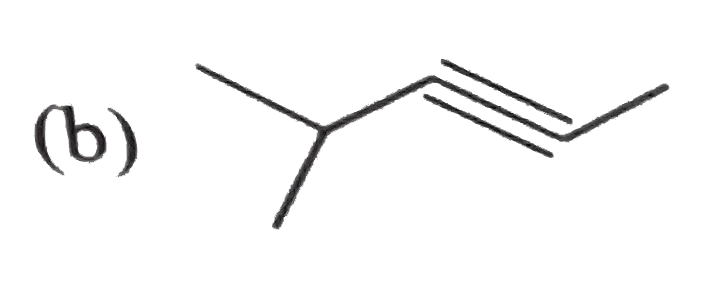Which among the following will give a precipitate with ammonical silver nitrate
2-butene
2-butyne
Chlorobenzene
3-methyl-1-butyne
The correct Answer is:D
To determine which compound will give a precipitate with ammonical silver nitrate, we need to understand the nature of the compounds listed and the reaction involved.
1. Understanding Ammonical Silver Nitrate:
Ammonical silver nitrate is a reagent used to test for terminal alkynes. When terminal alkynes react with ammonical silver nitrate, they form a precipitate of silver acetylide.
2. Identifying the Compounds:
Let's analyze the given options:
- Option 1: 2-butene: This is a non-terminal alkene. It will not react with ammonical silver nitrate.
- Option 2: 2-butyne: This is a non-terminal alkyne. It will also not give a precipitate with ammonical silver nitrate.
- Option 3: Chlorobenzene: This is an aromatic compound and does not have a terminal alkyne. Therefore, it will not react with ammonical silver nitrate.
- Option 4: 3-methyl-1-butene: This compound contains a terminal double bond but is not a terminal alkyne. However, if we consider the structure, it is actually a terminal alkyne.
3. Conclusion:
Among the options, 3-methyl-1-butene is the compound that will give a precipitate with ammonical silver nitrate due to the presence of a terminal alkyne.
Final Answer:
The compound that will give a precipitate with ammonical silver nitrate is 3-methyl-1-butene.
Ammonical silver nitrate is a reagent used to test for terminal alkynes. When terminal alkynes react with ammonical silver nitrate, they form a precipitate of silver acetylide.
Let's analyze the given options:
- Option 1: 2-butene: This is a non-terminal alkene. It will not react with ammonical silver nitrate.
- Option 2: 2-butyne: This is a non-terminal alkyne. It will also not give a precipitate with ammonical silver nitrate.
- Option 3: Chlorobenzene: This is an aromatic compound and does not have a terminal alkyne. Therefore, it will not react with ammonical silver nitrate.
- Option 4: 3-methyl-1-butene: This compound contains a terminal double bond but is not a terminal alkyne. However, if we consider the structure, it is actually a terminal alkyne.
Among the options, 3-methyl-1-butene is the compound that will give a precipitate with ammonical silver nitrate due to the presence of a terminal alkyne.
The compound that will give a precipitate with ammonical silver nitrate is 3-methyl-1-butene.
Topper's Solved these Questions
- HYDROCARBONBOOK - ERRORLESS CHAPTER - HYDROCARBONEXERCISE - ORDINARY THINKING (Objective question) (AROMATIC HYDROCARBON)
128 Videos
- HYDROCARBONBOOK - ERRORLESS CHAPTER - HYDROCARBONEXERCISE - CRITICAL THINKING (Objective questions)
24 Videos
- HYDROCARBONBOOK - ERRORLESS CHAPTER - HYDROCARBONEXERCISE - ORDINARY THINKING (Objective question) (ALKENE)
129 Videos
- HALOGEN CONTAINING COMPOUNDBOOK - ERRORLESS CHAPTER - HALOGEN CONTAINING COMPOUNDEXERCISE - Critical Thinking (Jee (Advanced) 2018)
1 Videos
- IONIC EQUILIBRIUMBOOK - ERRORLESS CHAPTER - IONIC EQUILIBRIUMEXERCISE - JS Jee Section (JEE Advanced (Numeric answer type question))
1 Videos
Similar Questions
Knowledge Check
Which one of the following will not give white precipitate with ammonical silver nitrate solution
ACH3=C∘C−CH3BCH3−CH∣CH3−C≡−CH3CCH3−CH2−CH=CH2Dall of theseWhich of the following will not give white precipitate with ammoniacal silver nitrate solution ?
ACH3−C≡C−CH3B C
C D
D
Which of the following will not give white precipitate with ammoniacal silver nitrate solution ?
ACH3−C≡C−CH3B C
C D
D
Which of the following will not react with an ammonical silver nitrate solution :
View SolutionWhich of the following will not react with an ammoniacal silver nitrate solution ?
View SolutionA metallic carbide on treatment with water gives a colouless gas which burns readily in air and gives a precipitate with ammonical silver nitrate. The gas is
View SolutionWhich of the following ions will give a coloured precipitate with lead nitrate solution
View SolutionWhich compound does not give precipitate with ammonical silver nitrate solution ?
View Solution
